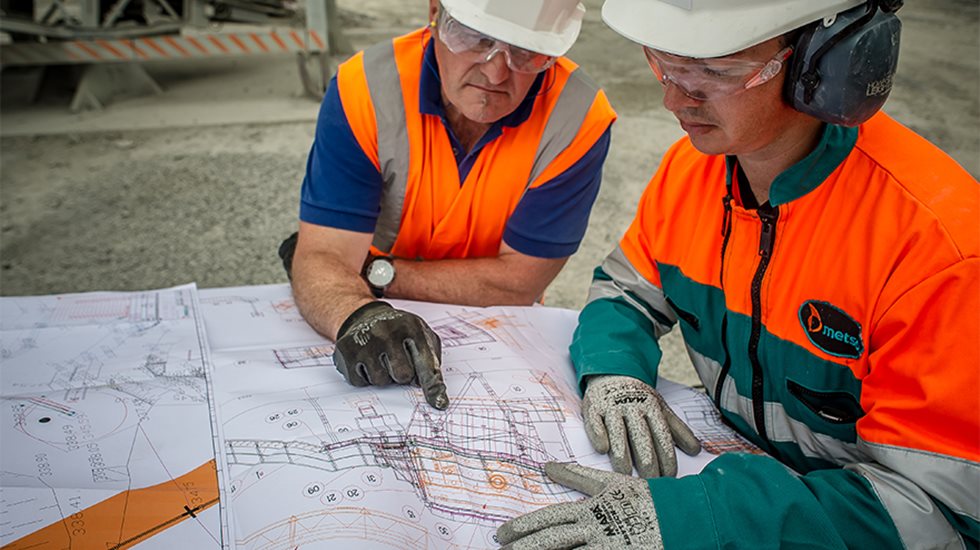A plant may have the latest crushing technology that can process high volumes of material, but this is of little use if it has to be limited because the screens or feed and output conveyors can’t keep up with it. In such a situation, new equipment or design tweaks can help to optimize productivity. We apply a holistic approach, keeping the plant’s production requirements and budget in mind, to ensure that the solutions we provide are fit for purpose and integrate as easily as possible into the existing process.
There are five typical steps that we follow when assisting a site to remove bottlenecks and achieve optimal productivity.
Step 1: Analysis of the entire aggregate plant
The very first activity we carry out is an analysis of the entire plant to identify issues and ascertain which equipment and systems require upgrade or improvement. This involves using software to estimate which process changes or machinery would bring the most benefit. Our analysis software allows us to input material characteristics like crushability, density, and abrasiveness, and then estimate the plant’s upgraded capacity with the proposed equipment. Our experts will typically spend one day on site and another day producing spreadsheets with target productivity figures.
Step 2: Designing aggregate site layout
Once this analysis is completed, our process experts – who ensure that the process for the new site layout is optimized – produce flow sheets for the upgrade. Sometimes we also invite additional experts such as automation engineers to analyze the process in more depth. Planning the new layout then takes about a day, after which our design engineer spends around a week taking measurements to ensure that the current structure has the space and load capacity for the new machines. The final step is to produce the new design. This process can be streamlined somewhat if the plant has existing design files available to work from, but it is generally done from scratch. The proposed designs are approved by our experts before being submitted to the customer.
Step 3: Proposal for the aggregate plant upgrade
The proposal is handled by our sales staff along with the plant’s management team, aided by the technical information in the flow sheet and layout and the results of our initial analysis. We estimate the capacity increase after our proposals are implemented and agree the upgrades to be carried out, the installation process, and the price. Although the expected increase in capacity we provide is an estimate, we do offer some level of assurance – normally a 5–10% deviation is considered acceptable, although the required output is only confirmed once we make a firm offer based on the agreed budget and the customer’s technical preferences.
Step 4: Aggregate plant upgrade implementation
The implementation process begins with ensuring that we have accurate measurements to work from. We then make some drawings and fabricate the structure and chutes for the new design, after which we can manufacture the required components. For a cone crusher for example, the process from drawings to final implementation will take around eight weeks; the process for a screen is slightly slower as manufacture takes longer and all of the chutes under the screen, as well as the conveyors, must be accurately measured.
Step 5: Starting up the aggregate plant
After delivery, the next phase is to install the hydraulic connection for a cone crusher, followed by electricity adjustments. Once installed, we ensure that the equipment meets the agreed productivity levels and run material characteristics tests in our lab to control the input data, as well as testing to ensure that the end product meets requirements for the flakiness index and curve. This process takes a few days, although sometimes we need to leave the equipment running for a while before testing. If anything is still not up to the required standard at this stage, we carry out further analysis, adapting the equipment and fine-tuning settings as needed.
The true benefit of our SiteBooster™ plant optimization solution is the level of experience that customers have at their disposal. Because we have a variety of experts exchanging knowledge and working in partnership with the customer, we are always able to answer their questions and fulfil even the most challenging requirements. Although there are many parties involved, the process is efficiently coordinated by one project manager, meaning that the customer has a clear point of contact.
Ready to supercharge your production?
Do you need assistance upgrading your stationary crushing plant to improve efficiency, reduce downtime, and remove bottlenecks from your processes? Our SiteBooster service helps plants to increase output, quality, and safety by carrying out a thorough site audit and then implementing agreed measures to achieve production goals.

